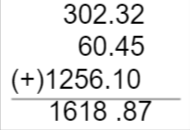Decimals are used in situations that require a higher level of precision level in terms of measurement metrics. Weights, money, lengths, etc. can be expressed in decimals. Just like whole numbers, we will also perform simple mathematical operations of addition, subtraction, multiplication, and division with decimals.
Further ahead in this article, we will look at the addition of decimals fractions in greater detail. 5th Grade Math Students will learn about the definition of decimal fractions, how to add decimal fractions, and some example problems on the addition of decimal fractions, and so on.
Read More:
- Worksheet on Addition of Decimals
- Adding Decimals
- Simplify Decimals Involving Addition and Subtraction Decimals
What is Decimal Fraction?
A decimal is defined as a fraction where the denominator is that the bottom number, which could be a power of 10 like 10, 100, 1000, and so on. You will write the decimal fractions with a decimal point and no denominator, making it easier to do calculations like addition, subtraction, division, and multiplication on fractions.
How to Add Decimal Fractions? | Rules for Adding Decimal Fractions
The addition of decimal fractions is performed by using the following steps:
Step 1: First, write the digits of the given numbers one below the other such that all the decimal points are in the same vertical line.
Step 2: Now, perform the addition of given digits from rightmost digit to left-most digit.
Step 3: Next, Place the decimal points of the sum vertically below the opposite decimal points.
Adding Decimal Fractions Examples
Example 1:
Find the sum value of 48.56 and 35.743?
Solution:
Given the values of 48.56 and 35.743
Now, we will perform the addition operation. We will get the final sum value.
The addition means adding given numbers and the resultant value is the sum.
Now, we will add one zero to 48.56 at the end to make equal numbers of digits.
So, the numbers are 48.560 and 35.743,
48.560 + 35.743 = 84.303
Therefore, the sum of 48.560 and 35.743 is 84.303.
Example 2:
Add 42.333 and 3.2?
Solution:
As given in the question,
Now, first, convert the decimals to like decimals.
Next, we need to add two zeros to 3.2 at the end to make the decimals like.
Now, line up the numbers according to the place values and then perform addition.
So, the numbers are 42.333 + 3.200
42.333 + 3.200 = 45.500
Therefore, the final value of 42.333 and 3.2 is 45.500.
Example 3:
Write the final value of 24.67+ 32.732+ 1.00+ 52.007?
Solution:
As given in the question, the values are 24.67, 32.732, 1.00, 52.007.
In between given numbers, the plus will be present. It means performing an addition operation.
But, we need to add one zero to 24.67 and 1.00 at the end to make the decimals.
So, the numbers changed to 24.670, and 1.000
After performing addition operation, the final is,
24.670 + 32.732+ 1.000+ 52.007 = 110.409
Hence, the final value of the given numbers is 110.409
Example 4:
Add $302.32, $60.45, and $ 1256.10 and write the final sum value?
Solution:
Given the values $302.32, $60.45, and $ 1256.10
Now, we need to find the final sum value using the addition rule.
The below figure shows, how to perform addition operation,

Thus, the final sum value of given numbers is 1618.87
Example 5:
The weight of a baby cat was 156.24 kg. After two years, his weight increased by 127.64 kg. Find the weight of the cat after two years?
Solution:
Given that the weight of a baby cat was 156.24 kg. After two years, his weight increased by 127.64 kg
The cat’s present age is 156.24 kg
After two years, his weight increased by 127.64 kg
Now, add both weights to get the cat’s age after two years
So, add 156.24 kg and 127.64 kg
156.24 kg + 127.64 kg = 283.88 kg
Hence, After two years, the cat weight is 283.88 kg
FAQ’s on Addition of Decimal Fractions
1. What are decimal places?
The position of a digit to the right of the decimal point in a number is written in mathematical (decimal) notation.
2. If the product of two numbers is 38.46 and another number is 658.17, what’s the opposite number?
Given,
One number = 38.46
Product of two numbers = 658.17
The other number = 658.17÷38.46
= 658.17/100 ÷ 38.46 /100
= 17.11
3. What are the types of decimals?
There are three types of decimals. They are
i. Recurring decimals(Non-Terminating or Repeating)
ii. Non-Recurring decimals (Terminating or Non-Repeating)
iii. Decimal Fraction
